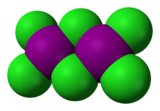Iodine trichloride
 | |
 | |
 | |
| Names | |
|---|---|
IUPAC name iodine trichloride | |
| Identifiers | |
CAS Number |
|
3D model (JSmol) |
|
ChemSpider |
|
ECHA InfoCard | 100.011.582 |
PubChem CID |
|
InChI
| |
SMILES
| |
| Properties | |
Chemical formula | I2Cl6 |
Molar mass | 466.5281 g/mol |
| Appearance | yellow solid |
Density | 3.11 g/cm3 |
Melting point | 63 °C (145 °F; 336 K) |
Magnetic susceptibility (χ) | −90.2·10−6 cm3/mol |
Except where otherwise noted, data are given for materials in their standard state (at 25 °C [77 °F], 100 kPa). | |
Infobox references | |
Iodine trichloride is an interhalogen compound of iodine and chlorine. It is bright yellow and in the solid state is present as a planar dimer I2Cl6, Cl2I(μ-Cl)2ICl2, with two bridging Cl atoms.[1]
It can be prepared by reacting iodine with an excess of liquid chlorine at −70 °C. In the molten state it is conductive, which may indicate dissociation:[2]
- I2Cl6 ⇌ ICl2+ + ICl4−
Iodine trichloride can be created by heating a mixture of liquid iodine and chlorine gas to 105 °C.
It is an oxidizing agent, capable of causing fire on contact with organic materials.
References
^ K. H. Boswijk; E. H. Wiebenga (1954). "The crystal structure of I2Cl6 (ICl3)". Acta Crystallographica. 7 (5): 417–423. doi:10.1107/S0365110X54001260..mw-parser-output cite.citation{font-style:inherit}.mw-parser-output .citation q{quotes:"""""""'""'"}.mw-parser-output .citation .cs1-lock-free a{background:url("//upload.wikimedia.org/wikipedia/commons/thumb/6/65/Lock-green.svg/9px-Lock-green.svg.png")no-repeat;background-position:right .1em center}.mw-parser-output .citation .cs1-lock-limited a,.mw-parser-output .citation .cs1-lock-registration a{background:url("//upload.wikimedia.org/wikipedia/commons/thumb/d/d6/Lock-gray-alt-2.svg/9px-Lock-gray-alt-2.svg.png")no-repeat;background-position:right .1em center}.mw-parser-output .citation .cs1-lock-subscription a{background:url("//upload.wikimedia.org/wikipedia/commons/thumb/a/aa/Lock-red-alt-2.svg/9px-Lock-red-alt-2.svg.png")no-repeat;background-position:right .1em center}.mw-parser-output .cs1-subscription,.mw-parser-output .cs1-registration{color:#555}.mw-parser-output .cs1-subscription span,.mw-parser-output .cs1-registration span{border-bottom:1px dotted;cursor:help}.mw-parser-output .cs1-ws-icon a{background:url("//upload.wikimedia.org/wikipedia/commons/thumb/4/4c/Wikisource-logo.svg/12px-Wikisource-logo.svg.png")no-repeat;background-position:right .1em center}.mw-parser-output code.cs1-code{color:inherit;background:inherit;border:inherit;padding:inherit}.mw-parser-output .cs1-hidden-error{display:none;font-size:100%}.mw-parser-output .cs1-visible-error{font-size:100%}.mw-parser-output .cs1-maint{display:none;color:#33aa33;margin-left:0.3em}.mw-parser-output .cs1-subscription,.mw-parser-output .cs1-registration,.mw-parser-output .cs1-format{font-size:95%}.mw-parser-output .cs1-kern-left,.mw-parser-output .cs1-kern-wl-left{padding-left:0.2em}.mw-parser-output .cs1-kern-right,.mw-parser-output .cs1-kern-wl-right{padding-right:0.2em}
^ Greenwood, Norman N.; Earnshaw, Alan (1997). Chemistry of the Elements (2nd ed.). Butterworth-Heinemann. ISBN 0-08-037941-9.
This inorganic compound–related article is a stub. You can help Wikipedia by expanding it. |